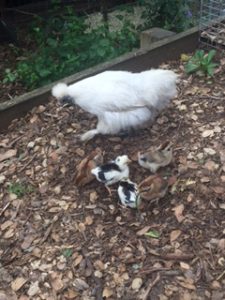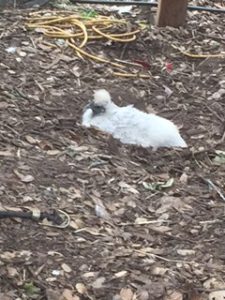I really can’t resist them, so when my Silkie hen began sitting on eggs, I isolated her and let her think she was hatching them. Three weeks later I went to the feed store and bought six baby chicks. That night I slipped out the eggs and slipped in the chicks. I brushed a little butter on the chicks’ feathers to absorb the mother hen’s smell.
 The next morning, the Silkie adopted the babies (who were several days older than newborn), and the babies bonded with the hen (even though they’d been born in a hatchery). It all worked just as if they had hatched right here.
The next morning, the Silkie adopted the babies (who were several days older than newborn), and the babies bonded with the hen (even though they’d been born in a hatchery). It all worked just as if they had hatched right here.
I kept them completely caged for a few days, then let them out for a bit. The first thing the Silkie did was leave the chicks and take a prolonged dust bath, as if to say, “I’ve been cooped up for weeks–I have to take a shower!”
After about ten minutes of dust bath, she rejoined the chicks and herded them around, teaching them what to eat and where to look for it. She makes the sweetest little clucks when she finds something interesting, and all the chicks gather round. Of course, it also trains me to bring them treats.
These chicks are straight run, which means not sexed, so there will undoubtedly be some eating birds. But the Pendesenca’s lay really dark brown eggs, so I hope I get at least two hens. The Mottled Houdans are more for show and for that wonderful name.
In any case, I think I’ve somewhat disproven Jose Saramago, who wrote, “However hard you may try there is never very much to say about a henhouse.”
Penedesenca
